- Home
- Services
- By Industry
- By Product Type
- Solid Roller Shutter
- Perforated Roller Shutter
- Punched Roller Shutter
- Grill Roller Shutters
- Garage Roller Shutter
- Insulated Roller Shutters
- Window Roller Shutters
- Sectional Overhead Doors
- Car Park Roller Shutter
- Fire Rated Roller Shutter
- High Security Roller Shutter
- Aluminium Roller Shutter
- Electric Roller Shutter
- Roller Shutter Repair and Maintenance
- Stainless Steel Roller Shutters
- About Us
- Resources
- Contact
- 02071832786
- 07401444143
- info@londonrollershutter.co.uk









